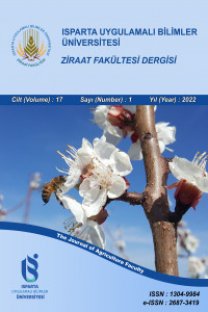Domates (Solanum lycopersicum) Bitkisinde Azot İçeriğinin Hiperspektral Algılama Teknikleriyle Belirlenebilirliğinin Araştırılması
Bu çalışmada, hiperspektral yöntemler ile domates (Solanum lycopersicum) bitkisinin azot içeriğinin kontrollü sera koşullarında belirlenmesi amaçlanmıştır. Sera koşullarında yürütülen çalışmada spektral yansıma ölçümleri için elektromanyetik spektrumun 325-1075 nm dalga boyları arasında yansıma ölçümleri yapabilen taşınabilir bir spektroradyometre kullanılmıştır. Çalışmada domates bitkisine iki farklı gübre çeşidi amonyum nitrat ve amonyum sülfat formunda, 5 farklı doz uygulaması yapılmıştır. Toplamda 120 saksıdan oluşan denemede 4 farklı dönemde her bir dozdan 3 tekerrür olacak şekilde örnekleme yapılmıştır. Domates bitkisinin hiperspektral algılama yöntemleri ile N içeriğinin belirlenmesinde, amonyum nitrat uygulanan domates bitkilerinin spektral yansıma grafiği görünür bölgede daha fazla çalışırken amonyum sülfat uygulananlarda ise görünür ve yakın kızılötesi bölgesinde daha iyi belirlenebildiği görülmüştür. Özellikle 4. dönemde uygulanan amonyum nitrat ve amonyum sülfat uygulamalarının her ikisinde azalan doz artışına bağlı olarak görünür bölgede yansıma yüzdelerini artırdığı, dolayısıyla bu dönemde domates bitkisinin N içeriğinin belirlenebileceği görülmüştür.
Anahtar Kelimeler:
Amonyum nitrat, Amonyum sülfat, Azot, Domates, Spektral Yansıma, Spektroradyometre
Investigation of The Determination of Nitrogen Content with Hyperspectral Detection Techniques in Tomato
The aim of the study was to determine the nitrogen content of tomato (Solanum lycopersicum) under controlled greenhouse conditions by hyperspectral methods. The study was carried out in the greenhouse conditions. A portable spectroradiometer capable of reflectance measurements between 325-1075 nm of the electromagnetic spectrum was used for spectral reflection measurements. In this study, two different fertilizer types, ammonium nitrate, and ammonium sulfate were applied to tomato seedlings in 5 different doses. The experiment has consisted of 120 pots in total which 3 replications of each dose have been sampled in 4 different periods. The spectral reflection graph of tomato seedlings which applied ammonium nitrate was shown more acceptable values in the visible region, whereas the ammonium sulfate applied samples could be determined better in the visible and near-infrared region. Especially in the 4th period, the reflectance percentages were increased in the visible region due to the decreasing dose. It could be determined the N content of the tomato seedlings in this period.
___
- Alpaslan, M., Güneş, A. & İnal, A., (2005). Deneme Tekniği. Ankara Üniversitesi Ziraat Fakültesi Yayınları, Ankara Üniversitesi Basımevi.
- Başayiğit, L. & Dedeoğlu, L., (2012). Elma Ağaçlarında Çinko Noksanlığının Görünür Yakın Kızılötesi (VNIR) Spektroskopik Yöntemle Belirlenmesi. Tarım Bilimleri Araştırma Dergisi, 5(2), 64-67.
- Bolat, İ. & Kara, Ö., (2017). Bitki Besin Elementleri: Kaynakları, İşlevleri, Eksik ve Fazlalıkları. Bartın Orman Fakültesi Dergisi, 19(1), 218-228. https://doi.org/10.24011/barofd.251313
- Fageria, N. K., (2009). The Use of Nutrients in Crop Plants. , New York. CRC Pres, Florida, Taylor & Francis Group.
- Jain, N. & Ray, S. (2007). Use of Hyperspectral Data to Assess the Effects of Different Nitrogen Applications on a Potato Crop. Springer Science+Business Media, 8, 225–239. https://doi.org/10.1007/s11119-007-9042-0
- Kacar, B. (1995). Bitki ve Toprağın Kimyasal Analizleri III. Ankara Üniversitesi, Ziraat Fakültesi, Eğitim Araştırma ve Geliştirme Vakfı Yayınları.
- Kantarcı, M. D., (2000). Toprak İlmi. İÜ Toprak İlmi ve Ekoloji Anabilim Dalı, İ Ü Yayın No. 4261, Orman Fakültesi Yayın No. 462.
- Kruse, J.K., Christians, N.E., Chaplin, M.H., 2006. Remote Sensing of Nitrogen Stress in Creeping Bentgrass. Agronomy Journal, 98:1640-1645.
- Thomas, J.R., Oerther, G.F. 1972. Estimating nitrogen content of sweet pepper leaves by reflectance measurements. Agronomy Journal, 64: 11-13.
- ISSN: 1304-9984
- Yayın Aralığı: Yılda 2 Sayı
- Başlangıç: 2006
- Yayıncı: Isparta Uygulamalı Bilimler Üniversitesi
Sayıdaki Diğer Makaleler
Kayseri İli Çerezlik Kabak Meyvelerinde Çürüme: Risk Faktörleri ve Öneriler
H. Handan ALTINOK, Ender Şahin ÇOLAK, M. Alper ALTINOK
Bitki fungal hastalıkları için antifungal ajan olarak uçucu yağlar
Mohamed SAİD OMAR, Şaban KORDALİ
Süt Sığırcılığında Irkın Sürdürülebilirlik Üzerine Etkisi
Hayati KÖKNAROĞLU, İsmail ÇINAR
Zeolit ve Feldspatın Alternatif Kireçleme Materyali Olarak Değerlendirilmesi
Kurutmalık Elma Dilimleme Makinası Tasarımı ve Prototipinin Geliştirilmesi
